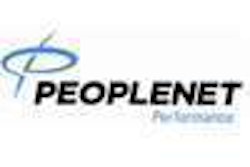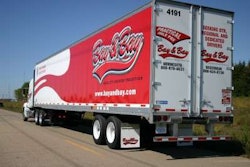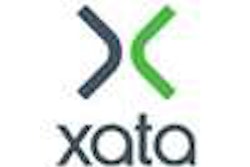Diesel prices may have dropped, but fuel still may be your biggest manageable. Better monitoring and control saves real money.
The fervor to fight fuel costs was unprecedented last summer as diesel prices surged toward $5 per gallon. No tactic or device was too insignificant to overlook. Fleet owners even were worrying about something they typically didn’t consider a problem: fuel theft. Thieves siphoned and drilled fuel from parked vehicles, and there even were reports of hijackers taking control of loaded fuel tankers. Some drivers were caught selling fuel using company fuel cards.
Maverick Transportation responded to the climbing diesel prices by tightening up its fuel network. The Little Rock, Ark.-based flatbed carrier also uses a fuel optimization software system that gives drivers fueling locations along their routes. Driver compliance to fuel plans is high because drivers don’t have many options for where they can fuel, says John Coppens, director of operations. “We have a fairly tight fuel network compared to other carriers,” Coppens says.
Although fuel prices have receded for now, no one knows if – or more likely, when – the cost of diesel will fly sky-high again. Consider that in the last downturn in trucking, today’s diesel prices would have been distressingly high. Look at ways now to monitor and control drivers’ habits behind the wheel and at the pump. Fleets and technology providers now are pushing the limits of what can be done to control fuel costs.
Driving down costs
Any real effort to conserve fuel must start with the driver. Getting drivers to change their behaviors requires a mixture of technology, training and incentives.
This year, Linde North America implemented a new training and incentive program that management hopes will deliver significant results. Linde North America is a division of the Linde Group, a global producer and supplier of industrial gases with U.S. corporate offices in Murray Hill, N.J. The largest division of its private fleet, Bulk Distribution, operates 750 power units.
At each location, driver trainers demonstrate proper shifting techniques, says Dennis Woods, senior fleet trainer for Linde’s southern division. Even veteran drivers can learn to save a significant amount of fuel by better understanding how newer engines operate best by shifting to stay in a lower rpm range for peak torque, Woods says.
Internal tests at Linde have shown that driving in the optimal torque band can improve fuel economy by 1.0 mpg. The company hasn’t conducted tests using loaded trailers, but since half of the fleet’s miles are run empty anyway, Woods estimates the company can save at least 1.0 mpg on each return trip.
To target drivers for training, Linde uses onboard computers to capture engine data; the drivers at each location with the highest rpms receive priority training. In addition to monitoring rpms, the company closely monitors speeds and the number of brake applications to look for proper spacing techniques. “Safe driving is fuel-efficient driving,” Woods says.
Linde’s new monthly driver incentive program includes categories for fuel performance, safety and compliance. Each 0.25 mpg a driver adds from last year will net him $25; a driver that improves by 1.0 mpg could receive $1,200 this year. “We pay the driver almost all of what we save in fuel,” Woods says.
Providers of onboard computing and mobile communications systems have made it increasingly easy and affordable for customers to track driver behaviors such as – but not limited to – shifting patterns, speed and idle time. Vendors also have added new features that allow drivers to monitor their own behaviors in the cab.
The latest release of Xata’s on-demand fleet operations software, Xatanet 4.3, includes a new Driver Fuel Analysis Summary report and a new dashboard option that allows Xatanet users to view idle time during a route, excluding all other nontrip time. This new reporting option allows fleet managers to monitor the driver’s impact on vehicle idling, the company says. Xatanet 4.3 also includes enhanced data-capture, which provides fleet managers increased visibility on fuel economy changes.
PeopleNet customers that use the PerformX engine connectivity product have a number of reporting functions through the Web-based PeopleNet Fleet Manager (PFM). PeopleNet also has offered an in-cab driver scorecard for several years. In March, the company is releasing new reporting dashboards in PFM that will allow fleet managers to compare driver behaviors, says Meghan Aubuchon, marketing manager.
Last October, Qualcomm added the Performance Monitoring Fuel Manager module to the Qualcomm Mobile Computing Platform. The module provides insight into individual driver behaviors that directly affect fuel consumption and provides fleets with the flexibility to compare drivers and vehicles, the company says. Individual driver performance scorecards and fleetwide comparisons can be generated on demand.
Establishing control
Burning less fuel is essential to controlling costs, but controlling purchases is key to ensuring drivers buy where you want them to and don’t buy more fuel than they need – an indicator of fraud or theft. Onsite fueling systems offer the greatest opportunity for control and security over fuel transactions. For example, the RF Fuel computerized management system from SCI Distribution controls the refueling of vehicles by using RF (radio frequency) and Wi-Fi communication to identify a particular tank, ensuring that fuel is dispensed only to authorized company vehicles.
For on-the-road and other offsite purchases, fleet cards now are standard tools for private and commercial fleets. Through a Web browser or direct interface with fleet software, fleet managers can limit daily fuel transactions by driver, dollar amount, gallons and location. Most systems require drivers to enter PIN numbers to authorize transactions, and some fleet card providers offer integrated real-time interfaces to the major enterprise resource planning (ERP) software systems. These interfaces let fleets establish fueling parameters based on such categories as truck and trailer number, trip number and odometer reading. Drivers are prompted to enter data at the pump, and the data is compared instantly to the live information in the ERP system; if any fields do not match, the fuel transaction is cancelled.
“One of the unique features that we have in our real-time interface is the load/unload functions,” says Bruce Larson, senior vice president of fuel card vendor T-Chek. When a new load has been created and a driver and tractor assigned, the interface detects this event and sends a request to the T-Chek host system to assign the driver to the tractor on the load, activate the card and assign the trip number to the driver and tractor.
In the digital age, the concept of a fleet “card” is evolving. IWX Motor Freight – a 200-truck refrigerated carrier based in Springfield, Mo. – has for a number of years used a cardless system from TCH that is integrated with its AS400-based dispatch system to validate fuel purchases in real time at all Flying J locations in IWX’s fuel network. Instead of swiping a card, drivers enter a card number and personal PIN number. The pump prompts drivers to enter trip-related information that includes their unit, trailer and trip number. IWX has never had a security lapse with the system, which allows the carrier to manage “card” numbers without having to manage physical cards, says Todd Staples, IWX fuel manager.
Improving compliance
Although theft can be a worry – especially when fuel prices are surging like they were a year ago – most fleets are more concerned with ensuring that drivers buy within designated fuel networks. Many fleets do what Maverick Transportation does – limit locations where drivers can fuel.
A.D. Transport Express – a Canton, Mich.-based truckload carrier – locks down its fuel network by utilizing software solutions provided by T-Chek in conjunction with fuel optimization software from ProMiles. Drivers are required to send a satellite request for optimization when they reach the one-half tank level. Dispatch feeds the fuel optimizer with the driver’s current location, fuel tank level and destination. The optimizer gives a recommended fuel stop, which is transmitted back to the driver. Simultaneously, dispatch opens the driver’s fuel card at the selected site for a one-time controlled fueling.
“We wanted to ensure that we controlled where fuel was purchased, rather than allowing the driver to make that decision for us,” says David Konopka, director of quality. All A.D. Transport fuel cards are locked down by default and activated only long enough to execute the authorized transaction.
Working with one of its largest fleet customers, fuel-card provider EFS Transportation Services recently developed a fuel purchasing application integrated with the in-cab communications system to limit the number of gallons and locations available to drivers. Even if the driver is using an authorized fuel stop, the EFS system reduces the number of gallons he can purchase if the system determines that the driver hasn’t burned enough gallons since the last stop to justify the full planned purchase.
H.F. Campbell and Sons takes a different approach by using incentives to get drivers to comply with fueling plans. The Harrisburg, Pa.-based company pays drivers a monthly performance incentive based on mileage. The 55-truck carrier has been using IDSC Expert Fuel, a fuel optimization program from TMW Systems, since 2001. The system integrates fuel purchase data to check for compliance with its optimal recommendations by fueling location and gallon amount.
“On a monthly basis, we check (fuel) compliance,” says Mark Campbell, vice president of finance. “If it is not 100 percent, that is drilled down, and the driver sits down with the president of the company.” If a driver has below 90 percent compliance, he loses a certain percentage of his miles from the incentive program. If a driver scores below 80 percent, he loses half of his miles.
“We used to be between 80 and 90 percent compliant,” Campbell says. “For a year and a half, we have been up to 98 percent compliance.” With only 2 percent noncompliance, Campbell hasn’t seen a need to further restrict the number of fueling locations available to drivers.
Better reports
In addition to integrating with various software applications to control and automate fuel transactions, fleet card systems also can collect real-time information for analysis. One of the most useful reports offered by card companies is the actual fuel economy for each driver and vehicle.
On a weekly basis, Maverick Transportation uses fuel purchasing data to closely monitor the mpg of each driver. If mpg changes by one-tenth or two-tenths, operations managers are tasked with determining the cause. “In today’s time, mpg is important,” says Dean Newell, the company’s vice president of safety and training. “We have a lot of focus on it.” Changes in mpg can be isolated between fueling events and compared to information from the vehicle’s computer and weather conditions, among other factors. “There are a lot of steps we can take,” Newell says.
Comdata has invested millions to develop a comprehensive Web-based reporting tool, says Bob Sneed, vice president of corporate payment solutions. Later this year, the company plans to add a new business intelligence platform for fleets to better manage the information collected at each fuel transaction. Using technology from Business Objects, Comdata will provide dashboard-style views of information, which will be configurable for each customer based on individual reporting needs.
Besides collecting real-time information on mpg, knowing the whereabouts of vehicles also is an important consideration in controlling fuel purchases tightly. This month, fuel card service provider Fleet One plans to add a new twist to its fleet fueling plan that allows its customers to monitor driver compliance. The company plans to release an integrated system for tracking fuel card transactions along with vehicle locations.
Since 2007, Fleet One has offered a customized vehicle tracking program powered by both cellular and GPS technology. If a fleet wants its drivers to stop at particular locations for fueling or maintenance and the drivers go elsewhere, Fleet One can create an e-mail alert to the fleet manager for noncompliance, says Tom Wagner, vice president of strategic markets for Fleet One.
Fuel prices may be beyond your control, but card controls provide everything you need to monitor fuel purchases and usage. Real-time fuel information and control mechanisms are becoming more critical in your never-ending fight to save dollars at the pump – a battle that’s certain to resume full-tilt once the current price lull ends.
Plugging leaks
Two South Texas fleets save fuel with anti-siphoning device
Information technology can be used to control and monitor every drop of fuel purchased and consumed, but a more low-tech approach may be the only way to stop determined fuel thieves.
Last summer, Robert Long and other executives at McAllen, Texas-based USA Logistics Carriers discovered that fuel was being siphoned regularly from about 50 of the fleet’s trucks. The culprits turned out mostly to be drivers looking to make a little extra money, or those who felt slighted in some way, Long says. Because most fuel theft came from the inside, buying locks for fuel caps was not a solution. “The driver still has access,” he says.
After investigating several products, Long purchased and installed the Acrafit anti-siphon device on all of the company’s 652 line-haul and day cabs. At the time, Long was transitioning between jobs from the chief financial officer of USA Logistics Carriers to CFO and board member of USI, a 70-truck carrier located in nearby Pharr, Texas. He also purchased Acrafit devices for all of USI’s 70 trucks.
USA Logistics Carriers since has experienced an increase in average fuel mileage from 6.8 to 7.2 mpg as a result of several factors that include regulating speed and installing the Acrafit devices, Long says. At USI, fuel economy has improved from 5.4 to 6.7 mpg by taking similar measures. Long estimates that the anti-siphoning devices alone have improved USI’s fuel economy by about 0.3 mpg. “It adds up a lot,” he says.
The Acrafit anti-siphon device from Paccar Parts is installed in the neck of the fuel tank. Its one-piece construction, with openings no larger than a quarter inch, keeps thieves from reaching the fuel with large-diameter siphon tubes, the company says. The Acrafit anti-siphon line includes various sizes to fit all major OEM fuel tank applications and comes with a 10-year unlimited mileage warranty.














